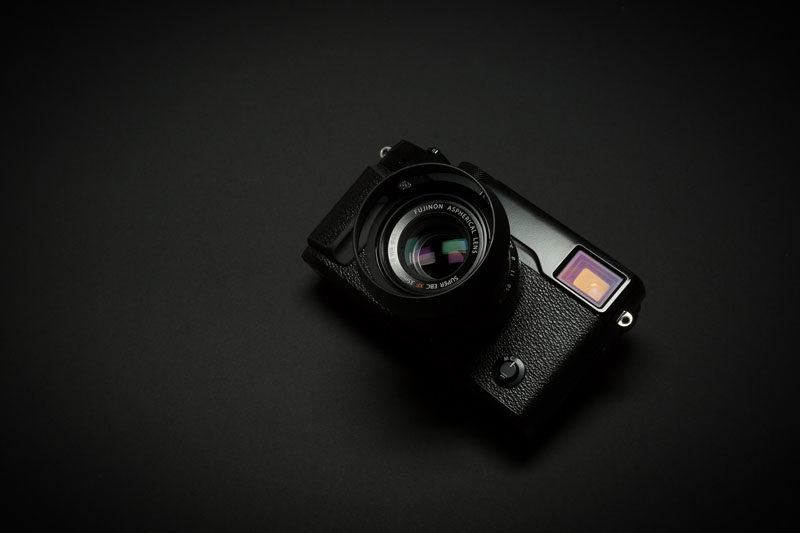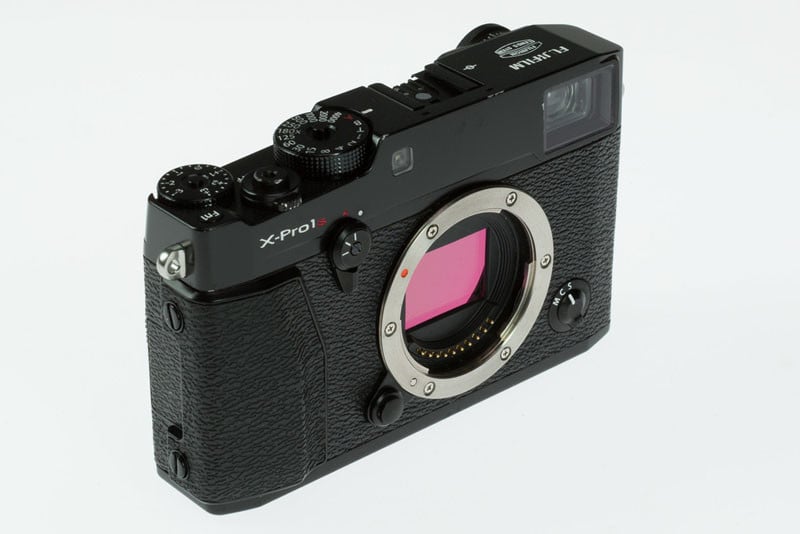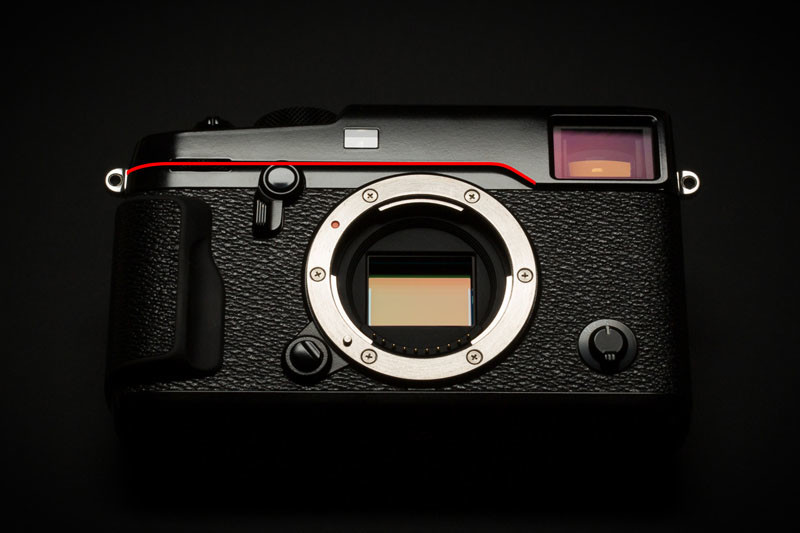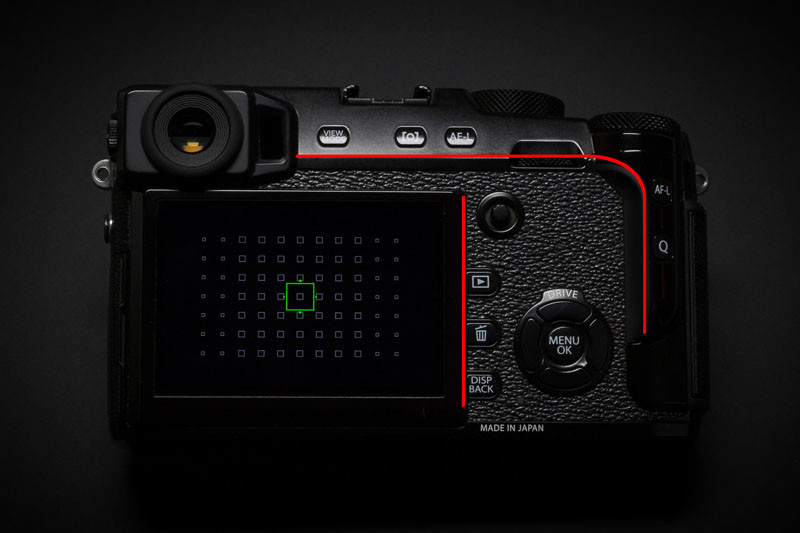
![]()
Digital cameras are notoriously difficult to design and get right. Where do you start? Who is the customer? What features do you include on the camera? There are uncountable ways to approach a camera development and design program.
For example, you can create a spreadsheet listing current and near-future ‘must-have’ specifications and cross them out one-by-one to please the techno-consumer. Or you can specialize and excel in specific areas—a more difficult proposition altogether. For the X-Pro2, Fujifilm chose the latter simply because of their heritage of crafting cameras for particular needs.
If you take a look at Fujifilm’s history of cameras, you get a sense of a company that sees photography not only as a technological endeavor but also an artistic one. For example, I have in the past used two remarkable Fujifilm cameras — the GX680 III and the GA645. The GX680 III is the largest SLR ever made. It’s a very specialized camera catering to product, interior and architectural photography. The superb Fujinon EBC lenses were attached to a front standard that in turn connected to the camera body with bellows. This enabled not only close-up shots with any lens but also enabled the front standard to have view camera movements — rise/fall, tilt, shift and swing. With this combination, you could shoot a small product that was completely in focus, as well as photograph interior and exterior architecture while correcting for converging parallels. It shot a rare 6 x 8 cm image on medium format film, which is close to magazine page proportions in order to minimize cropping.

The GA645 on the other hand was a slender 6 x 4.5 cm medium format shooter especially useful for photography on the go, such as travel photography. It had a fixed Fujinon 60mm f4 lens (37mm equivalent) that was tack sharp, full of contrast and had wonderful color rendition. Uncommonly, it had an accurate Program auto-exposure mode for spur of the moment shooting. Think about that for a minute. You’re shooting medium format like you’d shoot a compact camera. Of course, you could shoot aperture priority or manual but this camera was all about the possibility of shooting what you see and experience without needing to worry about settings — doubly true if you were shooting color negative film with its forgiving latitude. Try that with other medium format cameras.

I mention the GX680 III and the GA645 not because I’ve used them, but because they are perfect examples of four aspects that strongly inform Fujifilm’s camera design philosophy. First, top-tier optics. Fujifilm not only makes great lenses for their past and present still cameras but they are also leaders in the quality obsessed television and motion picture lens industry. Second, they craft cameras that satisfy a real need. Third, because Fujifilm is creating cameras for a specific need, their industrial design is well thought out and relevant to the act of photography. And last but not least, Fujifilm is the only camera maker that also makes film. This means a very deep understanding of colour.
Today we have the increasingly popular Fujifilm X series digital cameras. It seems as though a day doesn’t go by without finding an article online singing praises of the X series cameras (and here’s another one). But what, exactly, did Fujifilm do right to earn these accolades? Having been a X-Pro user for a couple of years and a X-Pro2 user for a couple of months, I had a pretty good idea what made these cameras so popular but I figured it’s better to ask the people behind these intriguing cameras themselves. So off to Tokyo I went.
Over three meetings in March and April of 2016, Jun Sato (industrial designer) and Takashi Ueno (product planner) were kind enough to have a conversation with me about the thinking that went behind creating the X-Pro2 in particular and the X series in general.
![]()
![]()
![]()
![]()
![]()
The Fujifilm X-Pro2 is arguably the most unique camera currently on the market. With its hybrid OVF/EVF viewfinder and tactile controls you have the possibility of shooting in a rangefinder-like fashion one moment and switch to a DSLR-like shooting mode in the next with a flick of a lever. Critical focus? Flick. EVF mode. Fast urban shooting? Flick. OVF mode and you’re in rangefinder country. It’s compact, light and feels durable. Even more so with the X-Pro2 because the camera is now weather sealed (you’ll need to pair it with WR, or weather resistant lenses for full water and dust protection). You can confidently shoot in the rain with no ill effects. The camera looks ‘retro’ but Fujifilm’s industrial designer isn’t paying lip service to a trend, as we’ll shortly see.
Jun and Takashi are a formidable team. Jun is the quiet thinker to Takashi, who has so much energy that if you could bottle his enthusiasm, you’d easily power half of Tokyo. It takes an army of people to create a complex product like a digital camera but this team of two is where ideas form, clash and coalesce almost daily. And the fruit of their labour is the X series that many admire, myself included.
The Thinking Behind the X-Pro2: ‘Quality You Can Sense’

Takashi is a firm believer in miniaturization — not for the sake of making something small, but because he believes in optimal and efficient results. He cites Leicas and compact cars as examples of how you take a big idea with a big form factor and reduce them to their essence in order to create products that are optimised. He also believes that a product needs to be fun. He says that cameras are like cars — they need to be fun when you use them. Rumour has it that he drives a vintage Ferrari. That indeed does sound like fun (insert envy emoji here).
Before getting involved in developing the X series, Takashi worked in Fujifilm’s film department. There he created an advisory group of professional photographers that helped hone Fujifilm’s film colour science. He says that the value of this advisory group was huge. It helped him understand real problems and needs as seen from the front line. It also helped him fully appreciate the nuances of colour reproduction and their uses. The reason why the X series succeeded, he says, is partly because of this experience and the fact that even today he involves professional photographers from around the world to gain insight into the needs and wants of their most trusted users. The now renowned Fujifilm colour palette and accurate white balance in the digital domain is the result of his experience working in the film department. For many photographers, the ‘Fuji Colour’ palette is the biggest selling point of the X series.
Takashi’s passion for all things photography keeps him very busy. On top of developing new camera systems, he is also a curator for numerous galleries, including the corporate gallery at Fujifilm’s headquarters. If you’re ever in Tokyo, you shouldn’t miss this space. In addition to the excellent photographs on display, they have a small museum of Fujifilm cameras going back decades. He also gives photography lessons to aspiring photographers through lectures all over the country. Like I said, he’s exploding with energy and his enthusiasm is quite addictive when you chat with him. If only some of that enthusiasm that he has in reserve will stay with me…
When it came to start the development of the X series, Takashi says they first chose the mount and sensor size. The APS-C size sensor was deemed the optimal size — big enough for professional imaging but small enough to create compact cameras. The product development team saw a real need where DSLR’s were becoming ungainly for consumers and pros alike. The X series was developed with portability and usability in mind — for taking pictures on the go. In other words, street, urban, candid portraiture, reportage, documentary and travel photography. The system needed to be light, compact, durable, offer a great shooting experience and capture photographs with sublime colour reproduction.
The X series was influenced by the aforementioned GA645 — a fixed lens rangefinder style medium format camera. In fact you can see a direct connection between the GA645 and the X100, at least in the thinking behind them. The idea was to create a camera that was fast to handle and a delight to take pictures with. Takashi is a big fan of Leica and the Contax G2 system as well. For him, they are great examples of optimisation and efficiency. So taken together, the three cameras were big influences on the initial X cameras.
These influences informed the nature of the camera from the start. Direct controls for exposure parameters would be needed. In turn, this implied that the aperture dial stays on the lens barrel. Dials for the shutter speed and so on. Two-handed operation was thought to be the ideal way to directly control the camera, enabling the photographer to make split second decisions on the fly. The optimal size, along with direct controls meant a high-quality (both as a camera and its film inspired colour palette) camera was born. From what I can surmise from my discussions with Takashi, the X series is all about mobility and decisive usability.
For the X-Pro2, the product development team pushed their engineering colleagues hard. Takashi says that, frankly speaking, they asked for the impossible. For example, they wanted to add weather sealing to the body, which normally increases the size of the camera body. But they insisted on no dimensional changes relative to the original X-Pro. All told, the engineers responded with a new camera body that not only had 61 sealing points but only 1mm increase in height and 0.7mm increase in thickness. Weather sealing was considered very important, following the development mantra of mobility.
The challenges that were given to the engineers didn’t end with weather sealing. They wanted a faster camera despite a higher megapixel sensor and faster processor. They wanted power, performance and battery life equal to the original X-Pro. Takashi says that they even worked with the engineers to perfect the shutter sound by investigating various damping materials while keeping an eye out for durability. Vibration damping and feel-good tactile physical controls were also in the product development team’s sights.
It’s this obsessive attention to detail that amounts to what Takashi says is ‘quality you can sense’.
Industrial Design of the X-Pro2

Fujifilm Design Center’s Jun designed both the original X-Pro and the new X-Pro2. The way he approached the industrial design of the cameras starts with his passions. His biggest passion is for what he calls ‘golden age’ products. He explains that ‘golden age’ products are at the peak — where the original ideas are full formed and beautiful to see and use. As an example, he showed me pictures of his vintage 1930’s bicycle. He rides this bicycle every weekend in a gentlemanly way — never in a rush, just enjoying the ride. Jun says he loves nature, and cycling helps him connect to the world around him. He’s also an avid fly fisher.

Jun says that all products start with an idea. Money is invested in the idea and it slowly improves over time until the original idea is realised, or even bettered. He says if you drew a graph, it’ll look like a pyramid. The left hand slope is the investment slope and the right hand slope is where you cheapen your product in order to compete as more companies join the market. At the pyramid’s peak is the golden age of a product. Jun says that golden age products are confident. They aren’t snazzy. They’re honest and authentic with not a fibre of pretension. And his aim in his industrial design work is to always try to reach for the golden age—the peak of the pyramid.
He’s also heavily into creating custom vacuum tube amplifiers. The tubes he says are sourced from around the world and he showed me a picture of a rare pre-war vacuum tube on his phone. For Jun, audio equipment was at the golden age in the latter part of the vacuum tube era.

I asked Jun where the initial concept for the X-Pro2 came from. He said it was a combination of his ‘golden age’ thinking and that he wanted design a camera that people will use, rather than collecting dust on a shelf. Jun strives for sense of value and meaning in his industrial design work that he hopes will come across to the eventual users of the X-Pro2.
Industrial Design Mock-Ups
Industrial designers create visual mock-ups (non-functioning, realistic models) to verify the human interface (physical control placement), hold, weight, finish and aesthetics. I’ve been provided with three mock-ups:![]()
![]()
![]()
![]()
The mock-ups provides us with a peek into Jun’s thinking when he was designing the X-Pro2. The control layout on the back of the mock-ups explore different control positioning, and the mock-ups differ in the grip design as well as the overall look-and-feel of the camera. One of the mock-ups has a large radius on the top for a softer image. The final design of the X-Pro2 is born out of the thinking behind these mock-ups (and countless more).
Mockup 1
Mock-up 1 has an interesting ISO dial on the back of the camera. It has a digital numerical readout of the ISO setting. To its left there is a multi-function dial.
![]()
![]()
Mockup 2
Mock-up 2 is a softer look X-Pro2, along with a rougher texture for a different look from the original X-Pro. On the back, a lot of interesting things are going on — the ISO dial is embedded into the thumb grip and there are two dials, which I assume are multi-functional to the right of the LCD screen.
![]()
![]()
Mockup 3
Mock-up 3 is notable for its detachable grip and being the only mock-up to have the model name on the front.


![]()
The X-Pro2 is a compact camera with limited space for controls—more so than a DSLR type camera due to the rangefinder, negating that space. Choosing which controls will grace the camera can be a difficult task. Because the X-Pro2’s credo is decisive usability, Jun opted for direct access to as many exposure parameters as possible. If you compare the top plate of the X-T1 and the X-Pro2, you’ll see that the ISO dial on the left shoulder on the X-T1 has been incorporated into the shutter dial on the X-Pro2. To some, this may seem ‘retro’ but it is, in fact, a way of saving space while retaining access to ISO parameters with a physical control. The dial offers shutter speeds by turning it and ISO parameters by lifting and turning the dial. A small window indicates the ISO sensitivity setting. Normally, this type of dial wouldn’t be a big deal but it has weather sealing, which, as far as I know is the first of its kind. According to Jun, the dial is very complex because of it—it is composed of no less than 38 parts and the dial itself is made from metal.
Jun offers two insights into how the ISO dial can benefit users. First, if you pinch the dial with your index finger and thumb and position them so that the thumb is resting on the wall next to the hot shoe, when you twist it until your index finger touches the other side, you’ve made a one exposure stop change. For example, if the ISO is set to 200, twisting it until your index finger touches the front wall next to the hot shoe will make it 400. Exactly one ISO stop more. This is deceptively simple to do and once in muscle memory, a reflex. Further, Jun says that the both the OVF and EVF shows the ISO stop so you’ll always know which setting the ISO dial is at.


The X-Pro2 is designed to enable photographers to use the camera without taking their eye off the viewfinder. All controls, except the top plate, are laid out along well-defined character lines on the camera. Looking at the front, a character line starts just right of the lens mount and continues around the camera to the back. You’ll notice that dials and buttons are arranged along this character line to help you find your way to a specific control by feel. The idea is to making it easy to make a mental map of the controls, thereby aiding in muscle memory learning.
The right edge of the LCD screen is also a tactile guide for the three buttons next to it. The thumb support’s scooped out edge is another guide for the two buttons there. The AF knob and the four-button + centre button menu keys are positioned in familiar and easy to reach places. Having controls in predictable, reachable places means new users can easily find their way around the camera and instinctively learn to memorize the whole camera interface. Jun said that his goal was to create an interface that lends itself to ‘use without thinking’.
Part of this line of thinking when applied to the controls layout is Jun’s quest for the simplest form. He says that creating something that’s ordinary and common sensical is very difficult to do. For the aesthetics of the camera, he strove for ‘plain but cool’.
The X-Pro2 is designed specifically to enable photographers to react to a scene without the camera getting in the way. Of course, you can do that with any camera when you get to know it well enough — but in my opinion the X-Pro2 excels at it. It just makes me want to take pictures. It feels effortless and I cannot be happier with the results.
In my work as an industrial designer, I’ve often seen designs come alive and gain a sort of, for lack of a better word, an ‘aura’. Not cool or beautiful or anything superficial like that. It’s an elusive thing and hard-fought to achieve. It’s difficult to explain but an industrial design gains an ‘aura’ when everything about it holistically melds together to create a strong character. It’s definitely there in the X-Pro2.
Parting Thoughts
All cameras are created by passionate people and what you hold in your hands when you pick up the camera is the result of a lot of thinking by a lot of people. In the end, you’re holding the industrial design. It’s not often you hear about the design thinking behind cameras. I hope this article offered unique insights into the creation of the X-Pro2.
As I’ve mentioned at the beginning of this article, I have been a X-Pro2 user now for 3 months. Rarely has a camera given me such pleasure to use. It’s fun and easy to photograph with, which I think you’ll agree means that Jun and Takashi succeeded in reaching the goals set for this camera. My favourite quotes are ‘decisive usability’ and ‘plain but cool’, which perfectly expresses what the X-Pro2 is all about.
The X-Pro2 is definitely not ‘retro’ and definitely not retro for the sake of being fashionable. It’s a camera that is aimed at a specific type of user, as detailed in this article. And if you’re just that type of user, you’re in luck because there simply isn’t a better camera system out there right now.
The neat thing about the X-Pro2 is, at least for me, it’s the first camera that I could use for work and then use the same camera for casual events. The X-Pro2 is a versatile and fun camera that makes you love shooting all over again. As Jun and Takashi said to me, what would be the point of a camera if it didn’t?
About the author: Aage Granaas is a photographer, industrial designer, and entrepreneur. He writes about photography, camera development, and industrial design on his journal, Senzo. This article was originally published here.

